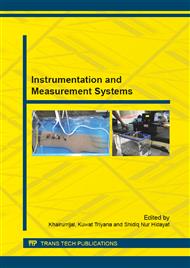p.3
p.9
p.13
p.17
p.21
p.25
p.29
p.33
p.38
An X-Ray Detector Using a Fluorescent Material ZnS:Ag Attached on a Phototransistor in Darlington Configuration
Abstract:
X-rays have been widely used in medical imaging system. CT Scan is one of the important diagnostic equipments in medical field that uses X-rays as a probe. In the latest CT-Scan generation an array of X-ray detector in a gantry is employed. Solid state detector and gas filled detector are currently used. These type of detector have relatively large in physical size. This influenses the size of the machine as well as its performance. In order to obtain an X-ray detector in a small size a phototransistor was exploited. The phototransistor was attached on a fluoroscent screen and arranged in Darlington configuration. The phototransistor in Darlington configuration was calibrated using visible light. The results showed that there was a linear correlation between the phototransistor output (mV) and the light intensity impinging on the phototransistor surface. A fluoroscent material (ZnS:Ag) then attached on the phototransistor surface. They work as an X-ray detector and calibrated using an X-ray beam generated from an X-ray machine. The results also confirmed that there was a linear correlation between the detector output (mV) and the X-ray intensity stricking the detector surface. The active area of the detector was explored by scanning the surface of the detector in vertical as well as in horizontal directions. The effective diameter of the active area of the detector was found to be 2.2 mm.
Info:
Periodical:
Pages:
21-24
Citation:
Online since:
July 2015
Authors:
Keywords:
Price:
Сopyright:
© 2015 Trans Tech Publications Ltd. All Rights Reserved
Share:
Citation:


